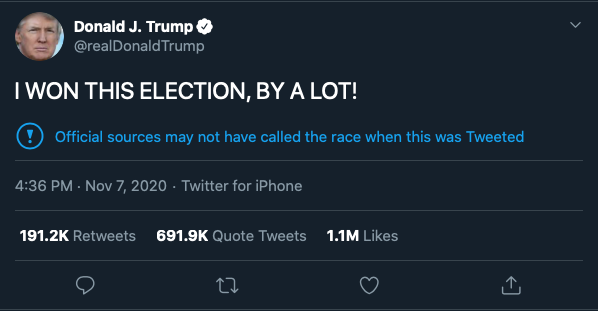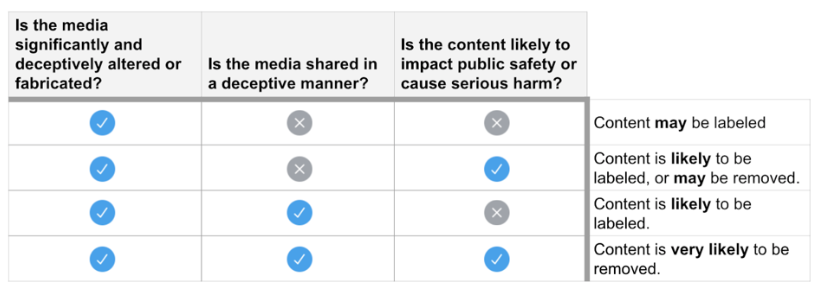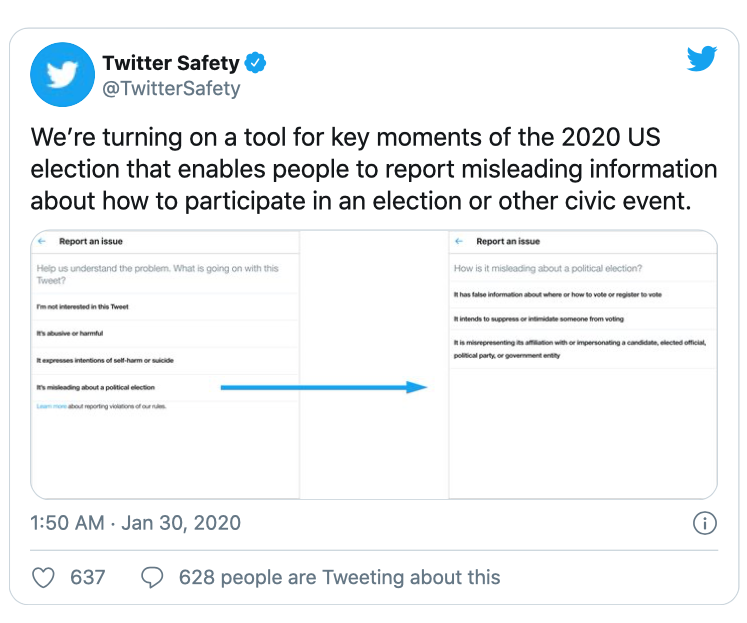I dare to say that everyone who will read this post has heard that President Trump has not been re-elected, and that the 81-year-old Biden will take over the job. I am glad, happy, and above all: relieved. Though, it is yet to discover how Trump will cope with his loss. As he files lawsuits in multiple states, he will not make amments with the election’s outcome. Since Trump is not the biggest fan of using facts when it comes to making statements, the next couple of months will be a surprise for us. What did not surprise me, was the way Trump presented himself during the elections on Twitter.
Trump proved the world over and over it would be Twitter’s job to make sure his claims should be marked as disputed. The 45th president of the United States continued to tweet false claims that the election had been stolen, and the only public statements he posted were adamantly in favour of winning. As shown below, Twitter labeled many Tweets as misleading or disputed. On Thursday, half of his fourteen Tweets have been labeled by the social media company.
But why is Twitter labeling these Tweets? According to Twitter, the US midterms in 2018 was with more than 99 million Tweets the most Tweeted-about elections. The majority of these Tweets were written by people who urged everyone to register to vote, who wanted to articulate their meaning about candidates and arguments. As the social media platform wanted to maintain a truthful discussion that was based on facts, measurements were taken. Tweets with tricky content, containing voter intimidation, false claims and information in relation to voting were being removed. During these election, the number of such Tweets was not big, though, these measurements weren’t for nothing and they were useful for about 6,000 posts.
After these elections, the social media platform took it even a step further. In order to protect the public conversation, Twitter started in with proactive detection and monitoring accounts who show concerning behavior around the US elections. Twitter chose to support voter participation as well, just as the importance of fact-checked information. This is the point where labels became a thing. Through these labels, the platform seeks to help people identity manipulated video, photo or audio content.
The labels we see under Trump’s Tweets are a continuation of what I’ve written above. It is special US election tool in order to help readers identify misinformation and fact-less claims. All Trump’s statements about voter fraud should be substantiated by information and the truth. Through this, voters and the election’s integrity would be protected.
With all the fake news, lies and claims going around in the (online) world, Twitter took an important step towards transparency and protecting the public conversation concerning the elections that have been on our minds for a long time this year. Let’s hope that this will not be necessary in the upcoming (midterm) elections, but like I’ve said about the upcoming months in Washington DC: it is all yet to discover.
Sources:
https://about.twitter.com/en_us/advocacy/elections-integrity.html
https://twitter.com/realDonaldTrump/status/1325099845045071873
https://www.nytimes.com/2020/11/06/technology/trump-twitter-labels-election.html






As an avid Twitter user myself, I appreciated that Twitter took steps to address its responsibility to the public. However seeing these labels from Cairo, Egypt, scrolling through my mainly Russian-language feed made me ponder which public is it exactly. Granted, Trump’s audience is much larger than just Americans, but I believe this warrants a larger discussion about the prominence of USA on the supposedly worldwide web.